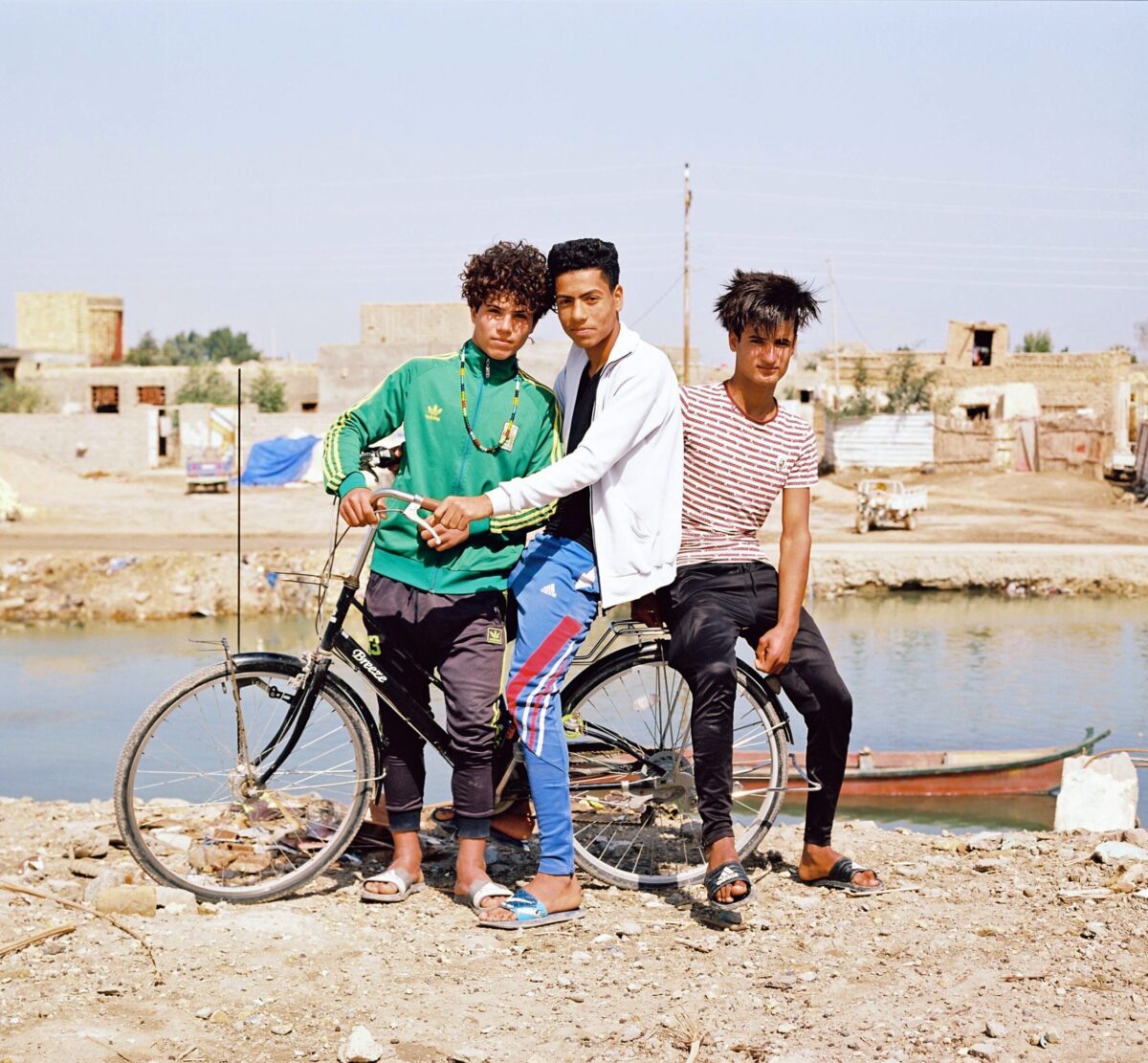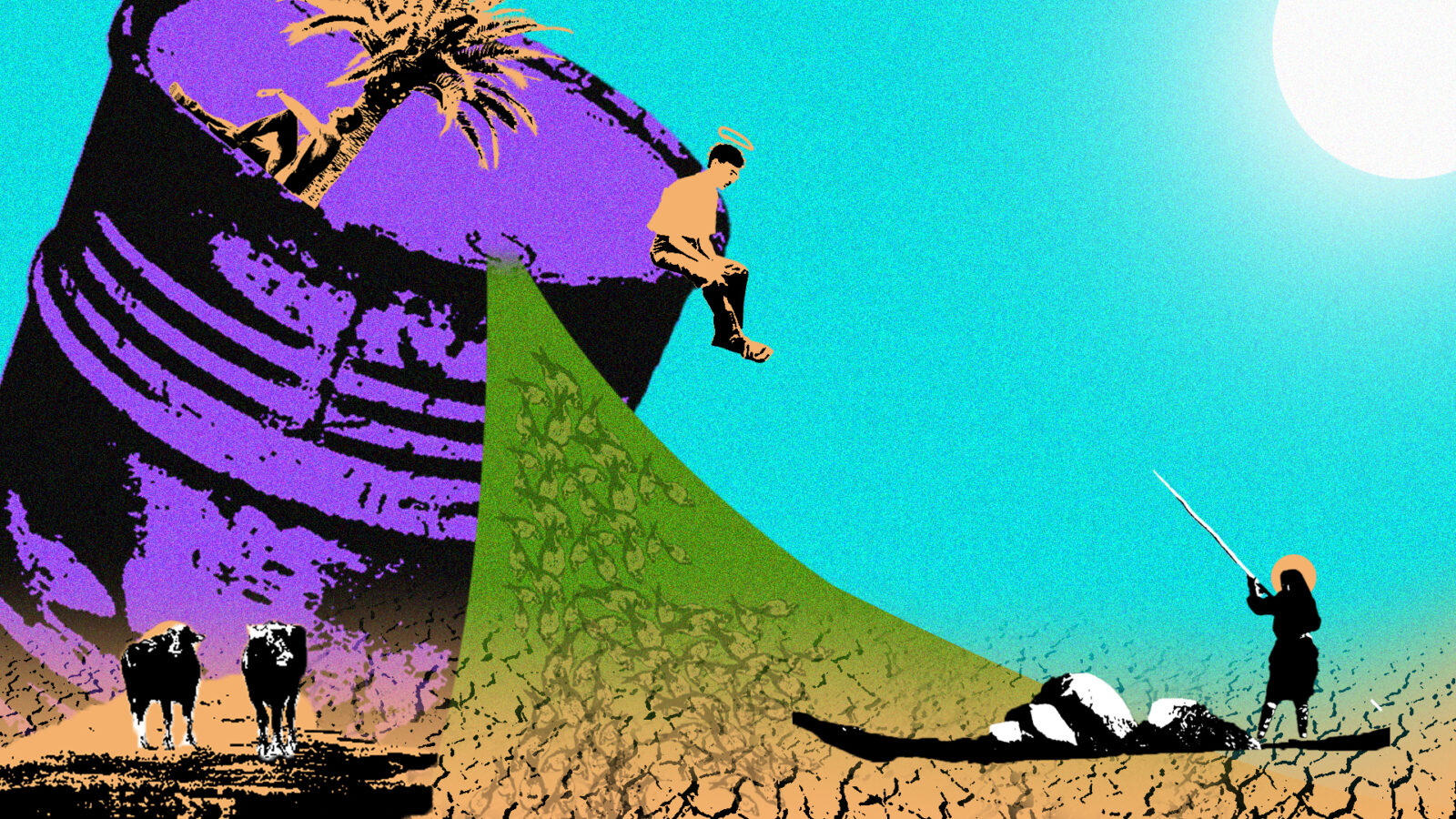This article is available in Arabic as part of a collaboration between MER and the independent Iraqi media initiative Jummar.
Iraq’s ecological devastation was set in motion years before the 2003 invasion.
Mehdi, Abbas and Eidan hanging out after school in the town of Chibayish, near the Iraqi Marshlands, 2018. Tamara Abdul Hadi
For 40 years, the Iraqi state has lurched from crisis to crisis as wars and domestic conflicts have devastated the country’s infrastructure and institutions. The Iran-Iraq war was followed by 13 years of punishing economic sanctions, which began in the 1990s. The 2003 Anglo-US invasion of Iraq has left the state, 20 years later, in political and economic disarray.
These shocks have taken tolls on the environment by displacing water resources, eroding infrastructure that could mitigate climate damage and enabling the unfettered extraction of oil. They have rendered Iraq—a country that has always faced occasions of extreme heat and aridity—among the more vulnerable countries in the Middle East to climate change.
From drought to sand storms to chronic illnesses related to the toxic pollution emanating from oil fields in the south, it is clear that climate conditions in Iraq have noticeably worsened in recent years. This trend is especially damaging when combined with the general decline in state and institutional capacity after 2003.
Yet, the same political and social upheavals that make the climate crisis so pressing have also led to the neglect of climate research in favor of what are perceived as more immediate threats, despite the interconnectedness of these predicaments. Indeed, rather than separate issues, the state of the Iraqi government and its economic and geopolitical entanglements are the main drivers of Iraq’s climate vulnerability today, as exemplified by its two most important resources: water and oil.
The Rise and Fall of Iraq’s Wetlands
Over the past two years, Iraq has experienced its driest seasons in decades, with temperatures frequently surpassing 120 degrees Fahrenheit. As temperatures continue to soar, water supplies decline, triggering one of the worst droughts in 40 years. Iraqi officials estimate that water reserves have decreased by half this year, due in part to changes in weather patterns but also to the action of neighboring countries, like Turkey, where several dam projects limit the water flowing from the Euphrates and Tigris rivers. For example, the operation of Turkey’s Ilisu Dam, a mile-wide mega-construction on the Tigris river, has reduced Iraq’s share of the river’s water by an estimated 60 percent. As a result of these declining water flows, a significant portion of Iraq’s wetlands dried out this year, leaving behind dead buffalo and displacing communities.
As a result of rising temperatures and severe droughts, recent years have also seen an increase in the frequency and intensity of sand and dust storms. According to the Iraqi Ministry of Environment, established after 2003, sand and dust storms have increased from 243 to 272 days per year between 2022 and the prior decade. Over just two months of 2022, Iraq experienced ten sandstorms, compared to averages of one to two storms a year in previous decades.[2]
Desertification is forcing farmers to abandon their land and migrate to overpopulated urban centers, where they find limited employment opportunities in the bloated public sector, driving many into the illegal and informal economy.
The rise in frequency and severity of sand and dust storms has also increased long-term respiratory illnesses among the population. In 2022, according to the health ministry as many as 10,000 people were hospitalized as a result of sandstorms. These numbers are likely higher on the ground, and the true magnitude of the crisis is not fully captured due to a shortage of official numbers and research.
Iraq’s Oil Dependency and Climate Vulnerability
The story of Iraq’s environmental vulnerability is not just about the scarcity of water but the abundance of oil. As the main source of income and wealth for Iraq’s political elites, the oil industry has contributed to the de-prioritizing of climate issues, in general, and water infrastructure in particular.

Read this article in Arabic at Jummar. Image designed by Atef Al-Jaffal/Jummar.
Iraq’s economy depends on oil. Over the past decade, the oil sector has accounted for more than 99 percent of Iraq’s exports and 42 percent of GDP. Oil dependency increases Iraq’s climate vulnerability due in large part to gas flaring—the burning of natural gasses associated with oil extraction, which releases a highly polluting mix of carbon dioxide, methane and black soot into the environment.
The sector captures and processes only around half of the 3 million cubic feet of gas produced per day from oil extraction, making Iraq the second-largest gas flaring country after Russia. Iraq releases around 30 million tons of carbon dioxide a year, accounting for 10 percent of the greenhouse gasses emitted globally due to flaring.[3]
By failing to develop its gas capturing infrastructure, Iraq is not only contributing to global carbon emissions. Flared gas also releases toxic chemicals like benzene, contributing to the increased formation of poisonous clouds and acid rains, which seep into the ground and dissolve essential nutrients like magnesium and calcium. These nutrients are necessary for agricultural development and the maintenance of arable land. Acid rain is further responsible for releasing aluminum into the soil, limiting the growth of healthy plants. Oil-tainted water and other toxins also drain directly into natural water sources, polluting them in the process. Iraq’s southern cities and towns—like Nahran Omar in the province of Basra—where most of the country’s oil fields are located, are particularly vulnerable to these environmental disasters.
In Nahran Omar, around 6 percent of the population of 1,500 has either died from or currently suffers from cancer or related health complications, and most of those with health complications are under the age of 25.[4] Thus, beyond the environmental risk, oil production and gas flaring as well as petrochemical plants and uranium from degraded weapons are all associated with a heightened risk of illnesses—such as asthma, hypertension and some cancers—especially among those who live near these oil fields.
Additionally, once the wells are built, companies infrequently hire locals to work in the fields, which means the population suffers from ecological and health consequences without access to economic benefits. According to reporting on the ground by Tareek Alshaab, oil companies are more likely to hire foreign workers. Around 100,000 foreign workers are working in the oil industry, and they are often paid higher wages than Iraqi workers.[5]
Iraqi government officials often downplay the number of pollution-related illness clusters around the country, limiting access to accurate numbers and data.[6] The limitation in data access is the product of both the state’s lack of capacity to develop the tools for capturing data as well as limited transparency of information when it comes to the energy sector and environmental concerns.
This limited political will combines with decades of declining infrastructure and institutional capacity to prevent meaningful progress. For example, if Iraq were to successfully invest in infrastructure to capture and use flared gas, it would both minimize the climate impact and potentially power up to 3 million houses, easing the country’s chronic electricity shortage. But investing in gas infrastructure would also mean Iraq weaning itself from dependence on Iran’s gas for electricity generation, especially during the hot summer months. Since 2018, Iraq has been receiving US sanctions waivers to import Iranian gas. This dependence is a lifeline for Iran’s struggling economy. Thus, neither Iran nor its proxies in Iraq are interested in developing better infrastructure.
Even when efforts have been made to minimize the negative impact of oil production and gas flaring, outdated infrastructure and limited state capacity have prevented real progress. For example, Iraq’s Environment Ministry—which five years ago merged with the health ministry—has documented the harmful impact of oil dependency and gas flaring on ecological conditions and the population’s well-being. The ministry has attempted to impose fines on the Basra Oil Company due to its multiple violations of gas flaring beyond the legal limits. But the state lacks the capacity to either enforce these rules or provide the necessary tools and resources to modernize oil production. Indeed, Basra Oil Company’s chief engineer acknowledged that it was cheaper to pay the penalty than invest in new infrastructure that could process flared gas.
The Basra Oil Company is not alone. Other international oil corporations, such as British Petroleum (BP), have for decades taken advantage of loopholes in emission reporting rules to save millions of dollars while releasing deadly gases into the atmosphere. For example, since 2009, BP has been the main contractor in the Rumaila Oil Field. One of the largest oil fields in the world, it is responsible for about one third of Iraq’s total oil production. According to a Greenpeace report, in 2021, Rumaila flared around 3.39 billion cubic meters of gas, emitting 9.5 million tons of carbon dioxide. Despite earning roughly $358 million of post-tax profit from this field, BP does not include Rumaila emissions in its annual emission report because it classifies the field as a “non-operated asset”—meaning the assets are operated by any person other than the company entities. But BP was the field’s official operator until June 2022, when BP and PetroChina established the Basra Energy Company to take over operations, and the company remains the main point of contact. If the company were to include Rumaila in its reports, its annual emissions for 2021 would be doubled.
In 2021, the World Bank and Iraq’s state-owned South Gas Company of Iraq, Shell and Mitsubishi signed a $360 million deal to help Iraq control its gas flaring crisis in its southern fields, but minimal progress has been made. Similarly, in September 2021, Iraq agreed on a $27 billion deal with France’s Total Energies. The deal would allow France to invest in Basra’s oil field for 25 years and develop several infrastructure projects targeting cleaner energy production and gas flaring control, but bureaucratic obstacles and political crises—such as the deadlock following the 2021 elections—have delayed the deal’s finalization.
Moving Forward
Since 2003, Iraq has faced several crises, but environmental conditions have often been deprioritized in favor of the country’s economic and political situation. Twenty years later, the country is in a more vulnerable position on its environmental front than perhaps any time before.
Iraq’s climate crisis is playing out in the drinking water, arable land and public health of those who live in Iraq. But it is also a regional and global crisis. Any effective response must consider the interconnected nature of climate issues with other social institutions, the role of civil and local communities and the need for effective geopolitical climate diplomacy. For the country to mitigate the impact of the structural weaknesses-climate change-instability nexus, Iraq must diversify its economy away from oil dependency, invest in decarbonization efforts and cleaner energy infrastructure and address the fiscal and political implications of this transition. Another important first step would be to center the interests and knowledge of local communities most impacted by climate change.
[Zeinab Shuker is an assistant professor of sociology at Sam Houston State University].
Endnotes
[1] World Bank Report: “Iraq Country Climate and Development Report,” (2022), p. xi.
[2] Muhammad Baqir Muhyedeen, “Iraq’s sandstorms are threatening life in the Fertile Crescent. It’s time the Iraqi government takes a stance,” The Atlantic Council, June 23, 2022.
[3] Alissa J. Rubin and Clifford Krauss, “Southern Iraq’s Toxic Twilight: Burning Gas and Poisoning the Air,” The New York Times, July 16, 2020.
[4] Ibid.
[5] Abdullah Latif, “100,000 foreigners work in the oil fields outside of regulations,” Tareek Alshaab, January 24, 2021.
[6] This information is based on author interviews.
